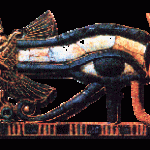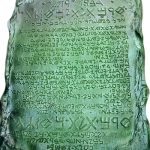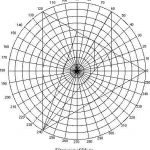It began the way such adventures often do these days, with a chance remark over
brunch in a trendy Colorado natural food restaurant. A man named for the Greek
sun god, Helios, was expounding on Eldorado, and I interjected a quote from Poe’s
poem of the same name. A conversation ensued and the town of Kanopolis,
Kansas, was mentioned as a point of some interest in terms of Native American
prehistoric cultures. I heard the word “petroglyph” and decided then and there to
stop in Kanopolis on our way back east.
Lady Sekhmet and I were in Boulder, emerging spiritual center for the
over-educated, self-indulgent technocrats of the new world order, attempting to
organize a school for geomantic studies. Geomancy, from the Greek words for
“earth divining,” is the current label for the emerging paradigm of sacred
geometry based planetary bio-systems engineering. Boulder seemed receptive to
our ideas and we left feeling positive, full of good vibes and pure intent.
Denver was our first detour. We stopped in town to see an exhibit of Tibetan art,
which turned out not be what we thought it was, and then, many hours behind
schedule, headed out across the plains. Eastern Colorado and western Kansas are
bleak and empty in mid May. Not even the new green of the endless wheat fields
relieves the monotony. The eye longs, as you speed down the interstate at 70
miles an hour, for some landscape feature on which to fasten. The bumpy bluffs
and hills of central Kansas appear at the end of the drive like a slight visual sigh of
relief.
An hour after nightfall, we rolled into Kanopolis looking for the local Bates’
Motel franchise. The town, a whistle stop on the Union Pacific line between
Ellsworth, the county seat, and Carneiro, a Portuguese ghost town, proved too
small to have any sort of accommodations. After driving around the deserted
streets for twenty minutes or so, we located a group of citizens chatting in front
of the police station. I stopped and asked about a motel, (the Bates’ franchise
turned out to be over in Ellsworth) and discovered that I was talking to the man
whose family had once owned Mushroom Rock.
Now, in looking on the map, I had noticed that the only thing of any interest
anywhere close to Kanopolis was something called Mushroom Rock State Park. If
Helios was correct, this should be the petroglyph site. However, our local original
owner seemed to know nothing of any petroglyphs, (“Pet-what?” “Stone writing.”
“No, I don’t think so. . .”) He recommended the Old Fort Hooker museum and
allowed as how there were some caves and such like. “Plenty to see here ’bouts,” he
called cheerfully as we drove off toward Ellsworth.
I have this theory about hell and small Kansas towns, evolved from a mixture of
Ray Bradbury and Sartre and Pierre Boule. I call it “There is No Exit from a Small
Town on the Planet of the Apes.” Should I ever be called upon to prove my
hypothesis, I shall offer Ellsworth, Kansas as an object example. We never found
the motel, never even came close. Much later, we arrived at the interstate, miles
from where we had originally turned off. Baffled, we drove on, looking for the fake
folksy warmth and rock bottom prices of a Motel 6.
The next morning we drove back toward Kanopolis, down the old stagecoach
route next to the Union Pacific tracks. Just past thedeserted sheep herding station
of Carneiro, we turned down a dusty road running back into the Smoky Hills.
Mushroom Rock State Park is a small five acre rectangle of hillside straddling a
drywash creek. The road runs through it, with a historical marker — telling us
nothing except that the overland stage stopped here — an outhouse, a few picnic
tables and an old well with a broken pump to mark the spot as a park.
What the site does have is some very unusual rock formations. Tens of millions
of years ago, a sheet of lava flowed out over a sandy sea bed, then, millions of
years later, upheavals broke the lava surface and water flowed down under and
through, washing away the sandstone. Now, compact car sized oval caps of gray
rock rest on the top of spindly khaki pedestals, defying gravity and looking like
nothing else but a mushroom.
North of the road, a small 10 foot high mushroom rock sits in a dell of tumbled
boulders with dolmen like cavities. This is the usual tourist spot, with a picnic
table nestled next to the mushroom. Most visitors gawk at the rock, have their
picture taken next to it, then move on down the road. The local teenagers
sometimes stop by for a few quiet beers at sunset, but even they seem subdued
and respectful, leaving little trash or graffiti.
South of the dirt road, past the old well with the broken pump and fifty yards
out into the field, stands the real treasure of the site. A massive oval of granite,
five feet thick by twelve feet across, floats 16 feet in the air atop a thin sandstone
base. Where the sandstone base meets the cap, it unfolds into four knobs which
supports the weight of the capstone. Rising out of the Kansas hillside, this rock
announces to the visitor that the normal laws of physics are likely to be a little
different around here.
So we discovered.
As soon as we parked, I jumped out and looped through the north side of the
park. I found it interesting but I was drawn across the road. As yet I had not seen
the other mushroom rock, but I felt guided, almost pulled, in that direction. I ran
smack into the energy of the place like one of those invisible barriers from the old
toothpaste commercials. I stopped and took it all in.
Back in the early seventies, I visited Stonehenge before the fence went up and
stood close to the center and watched the hairs on my arms crackle with static
charge. I had the same sensation of awe and deep earth connectedness at
Mushroom Rock, except that Mushroom Rock felt wild and natural in a way that
Stonehenge never could. Someone built Stonehenge, but only the earth itself
could create a Mushroom Rock. But, perhaps, someone had embellished on the
earth’s handiwork.
To my left as I stood at the edge of the site I saw, about fifty feet away and on
the crest of the rise above the drywash creek, a smooth piece of gray rock broken
in three pieces as if it had fallen. I looked closer and saw that indeed it had stood
upright at some point. Looking back from that spot I noticed a large slab of gray
rock which appeared to have a hole through the end of it, to the north of the
towering Mushroom Rock. Another shattered piece of rock lay on the hillside
south of the fallen stone. A cluster of boulders and upthrust rocks curved
between the holed rock and the mushroom. I groked immediately that while this
site was natural, a gift from the goddess, it had also been adjusted for use by
humans as a ceremonial center.
I gave the site a quick once over, stopping at the holed rock. The natural hole
through the rock lined up perfectly with the base of the standing stone to mark
the summer solstice sunrise. The hairs began to crackle and I decided, or was
inspired, to do a ritual using the cavity in the hole rock as an altar. Lady Sekhmet
arrived and agreed with my inspiration. She had felt a distinct presence on the
north side. As we headed back to the car for the magickal gear, a supercharged
Ford pickup topped the rise and stopped in front of the historical marker.
As we rummaged through the Subaru, Red and Ethel, self- proclaimed in
turquoise by their belt buckles, emerged from the pickup and walked over. Red
looked like an aging redneck cowboy, with a beer frog t-shirt pulled tight over his
beer belly and frizzy blonde fuzz steaming thinly up from an ultra-violet seared
scalp. His eyes blinked weakly in the morning sunlight as I asked about the other
end of the dirt road. “Only other thing ’round here is the Hill. . . over by Swede
town. . . down Route 4,” he answered finally. Red seemed surprised to be talking at
all, and Ethel stood quietly by as if waiting for the next calamity.
I thanked them, and they wandered off toward the picnic table under the small
mushroom rock. Lady Sekhmet and I gathered our magickal supplies and headed
across the road for the big mushroom. I had no plan for a ritual, so I simply let
the spirit of the place move me.
First, I offered tobacco to the four directions, then liquid to the rock people at
the hole rock for permission to use the space as an altar. Feeling no resistance, I
placed our amethyst candle in the center of the cavity and lit some incense. Red
and Ethel decided that they had seen enough of Mushroom Rock and left about
this time. The site settled into a deep quiet, and I began to arrange a pattern of
crystals around the amethyst candle. First I used the elemental crystals charged at
the Sirius synchrony to hold the directions. Around the candle, I placed the Earth
Reading Crystal in the east, the Crystal Vajra in the south and the Orb of Ra in
the west. The north was taken by the pentagonal polished amethyst, with the
open space to the south taken by the double terminated polished amethyst. These
stones were charged in the Ganges, the Potala and all the major temples up the
Nile as part of the ZET project.
We lit the candle in the center and Lady Sekhmet kept it going as I cast the
hyper-sphere around the site. The place rocked with surges of energy as I opened
each direction. The air felt thick, the sunlight seemed pale, and the shadows
turned a soft gray like a pre-dawn fog. Time passed, and I remember talking, but it
seems faint, like something overheard in a dream. I had the clear image of waves
of energy and consciousness flowing out from the spot and covering the planet. I
saw the wave bringing illumination and joy to everyone who could feel it. The
planet lit up with compassionate resonance.
Eventually we ended up in the center of the stone complex, equidistant from the
hole rock and the mushroom. I closed the ceremony, but left the space open
astrally for all to pass through in peace. I especially spun it so that anyone
entering the space would perceive the energy and treat the site with reverence.
This was very unusual, if not unique, behavior for me. I always close a space after
a working.
In putting the crystals back in their traveling bag, my hand touched a piece of
crystal we had found on the high altar of Osiris/Sokar/Ptah at Sakkara.
Immediately I knew that the place wanted this crystal, that the working would not
be complete without this last component. The altar at Sakkara is the site on an
annual spring equinox Djed raising ceremony and the place where we charged the
central crystal amethyst for the ZET project. Connecting this spot with Mushroom
Rock seemed natural, but I felt a reluctance to let the Sakkara crystal go.
Immediately I banged my head on the overhang of the hole rock’s cavity. I agreed
with no further discussion, and Lady Sekhmet and I planted the crystal as
instructed.
As part of this final component, I felt compelled to visualize a dome-like top part
of an icosahedron crystallized over the site. Like a large 3D pentagram, the image
locked into place with a distinct shift of energy, as if the lenses were suddenly
aligned correctly. Lady Sekmet and I felt an immediate rush of joy. We packed up
quickly and then spent a few minutes cleaning up the minimal trash in the
general area.
Lady Sekhmet found a rock that insisted that it wanted to go with her. She
brought it back and handed it to me for safe-keeping. I felt an instant tug as I put
in my pocket. While we were cleaning up, I noticed something on the western rock
of the complex that I hadn’t seen before. Someone had drawn the top of an
icosahedron just as I had visualized moments before. I took it as a good omen.
On the way back to the car, we discovered a sighting rock with a large hole
carved in it perfectly aligned along the north/south axis. It was a great spot to
view the Mushroom, and Lady Sekmet stretched out on the rock to get some
photographs. I felt the tug again as she stood up. She felt sick and demanded the
rock back. She put it in her shirt pocket and everything went back to normal.
Well, sort of back to normal.
Before we could get over the bridge across the drywash creek, I heard a roaring
sound and looked up to see a Stealth fighter banking away from the site at
treetop height. I was surprised to see a top secret plane flying so low over the
Kansas hills, but thought nothing more of it. Lady Sekmet and I sat at the picnic
table eating strawberries and watermelon, enjoying a quiet after ritual moment.
Suddenly, the roar returned and we looked up to see another Stealth fighter. This
one banked over us at maybe 300 feet and took a good look at us. Somehow, I
didn’t feel like waving.
We left soon after that. I noticed by the clock in the car that we had spent over
three hours at Mushroom Rock. In carefully going over the sequence of time, we
discovered a 45 minute to one hour gap in our memories. A ritual that should
have taken 30 minutes at most had gone on for close to an hour and a half.
Just as we were digesting this information, a flight of B-52 AWAC radar planes
flew over. They also circled and came back directly over Mushroom Rock. By then
we were far away, heading, as Red had suggested, toward the “Hill.”
One of my Teachers had a saying: “Strange travel plans are the dancing lessons of
God.” So it was that day. I felt uneasy going back to the interstate, so we followed
the flight path of the AWAC planes. They led us to a little town called Lindesborg,
Red’s “Swede town,” and just north of it we found Coronado’s Heights.
On his 1541 expedition, Francesco Vasquez de Coronado camped on the highest
point of the bluff overlooking the Smoky Hill River. Coronado was impressed by
the vast herds of “cows” and the natives who lived “like Arabs” among them. In
1936, the WPA decided to commemorate this encampment by building a stone
fortress on the highest point of the bluff. Now, the spot is a favorite local hang
out and end of school class picnic destination. The afternoon we visited, the place
was swarming with hyper-active kool-aid fueled kids celebrating the end of winter
and the promise of summer.
We stayed only long enough to banish the darkness lurking in the fortress, then
headed east toward Missouri. Eventually, we came back to the interstate, and soon
Missouri passed and Illinoisloomed across the great river. We made Mt. Vernon
that night.
The next morning, we made firm plans to drive straight home, however Lady
Sekmet made a wrong turn and we found ourselves on a back road heading for
someplace called Lake of Egypt. After a refreshing stop at the lake, we headed east
toward what we thought was a bridge over the Ohio River at Golconda, Illinois.
* * *
Strange travel suggestions indeed. A few miles from the lake we passed a small
entrance sign to Millstone Bluffs Archeological Site. Curious, we turned in and
discovered a truly unusual spot. Perched atop the bluffs is a walled fortress city.
Supposedly first inhabited by an unknown Archaic Woodlands culture around 400
AD, who apparently built the more than two miles of six foot high stone walls that
enclose the bluff top, Millstone Bluff was also home to a late Mississippian culture
from around 1200 to 1400 AD. The early settlers quarried the stone walls and
the bluff itself for building rock and millstones, hence its current name.
To the casual visitor reading the informational markers along the trail, this is
perhaps all you need to know. However, to anyone with even a passing
understanding of American prehistory, these dates and people are slightly off. The
fortress at Millstone Bluff, like half a dozen other sites in southern Illinois, does
not fit the accepted pattern of cultures and development.
In the 1960’s, archeologists and anthropologists more or less agreed on a broad
outline of American prehistory. At the end of the last Ice Age, around 15,000 BC,
waves of migrations crossed from Asia and swept down the North American
continent into South America. These waves of migrations evolved into orderly
time periods and traditions; the big game hunting paleo-Indians evolving into
Archaic gatherers and pastoral Woodlands cultures. Eventually the Woodlands
cultures began to build burial mounds, and even later the Mississippians,
influenced from Mexico, began to build flat-topped temple complexes. These
cultures declined and disappeared before the appearance of the white man,
leaving vast ruined earthworks.
In the 1970’s, a group of amateurs and experts from other fields began to point
out the enormous number of artifacts and sites that didn’t agree with that
orderly picture. Some of these objects pointed to contact with the Old World of
Europe over long periods of time. Some suggested that the whole dating scheme
was wrong and should be re-examined. North American archeology did not
respond to this onslaught of new information. Academics ignored or disparaged
the evidence, and public interest waned.
However, as the public attention turned elsewhere, the academics quietly began
to take up certain portions of the evidence. Today, the Visitor’s Center at Grave
Creek Mound in West Virginia will tell you that the tablet found in the mound
appears to be an inscription in ancient Celto-Iberian, and will even give you the
translation. It does not offer any suggestions as to how a Celto-Iberian tablet
found its way into an Adena burial mound dated 1,000 BC. This kind of schizoid
thinking colors much of academic archeology, creating situations such as
Millstone Bluff, where, in order to have anything to say, the facts must wedged
into a framework where they do not fit.
Archaic Woodland is a modern designation for the transitional state between
nomadic hunters and village based gatherer cultures. However, by the orthodox
chronology the area had long since become fully Woodlands culture. Mound
Builders like the Adena and the Hopewell ruleda vast religious and trading empire to the northeast. So who were these primitive Archaic Woodlands people who could build two miles of stone walls?
The later Mississippians are equally problematic. Their burials are typical late
Temple Mound tradition, which disappeared a few centuries before their arrival at Millstone Bluff. They built no mounds on the bluff, and their community seems to have been small and peripheral. They certainly didn’t build any stone structures.
The puzzle deepens when we consider the petroglyphs found at Millstone Bluff.
Called Mississippian for want of a better guess, the glyphs cover a triangular
corner of rock on the western edge of the bluff top. Most prominent is a
“thunderbird” image, surrounded by geometrical figures such as quartered circles, rayed circles and alphabetic shapes, called axes and pipes by the display. The thunderbird looks like nothing else in Mississippian art; its closest equivalent is the traditional rendering of a Phoenix.
So there we were, standing on the ramparts of Castle Phoenix. The petroglyph
rock pointed just north of west, back out toward Kansas. We did a small ritual to
open the flow along that Phoenix line. The small rock that insisted Lady Sekmet
picked it up turned out to fit perfectly in the carved eye of the Phoenix.
None of these adventures and discoveries were planned. It all started with that
chance remark back in Evergreen, Colorado. However, I felt guidance the whole
time, as if the land itself required our participation in these events. I’m not sure
what we did, but seeds have been planted and connections made. I can’t wait to
see what comes next…
Dr. Strange
More Articles from Sangraal.com:
Submit your review | |
I’m pretty woke and I know Dr. Strange is real and all, but I’m curious as to whether he actually wrote this, or if it’s some sort of fanfic. In my dimension he’s not supposed to be real. Fucking normies. -_-‘
-confused
I thought your article was interesting. I woke up this morning and saw a vision of circles group closed together like the geometrical shapes on this website. Im only now realising some of the meetings behind these sacred shapes. Thank you for sharing your amazing adventures!





